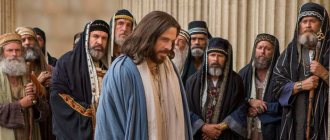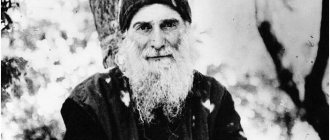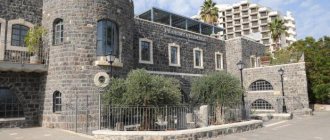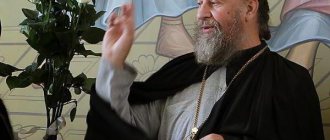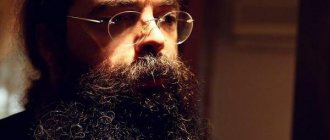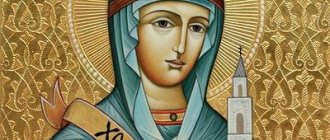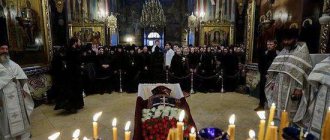From birth to monasticism
On October 5, 1934, Alexander Vafidis was born in Piraeus, an area in the Athens suburbs, raised in a strict Christian family. Since childhood, the boy dreamed of being ordained, so after graduating from school he had no doubt about choosing a specialty.
Archimandrite Emilian Vafidis
In 1959, after graduating from the Faculty of Theology, at the University of Athens, on the recommendation of a friend, Anastasius Yiannoulatos, the current Archbishop of Tirana, Alexander went to the monastery. The rector of the monastery, Metropolitan Dionysius of Trikala and Stagon, managed to win the trust of Alexander, who in early October 1960 took monastic vows with the name Emilian.
From monk to abbot of the Transfiguration Monastery
Staying within the monastery walls of Dusik, a month later the newly converted monk is ordained as a deacon. The dedication takes place in the church of St. Paraskeva in the city of Trikala, after which Deacon Vafidis serves in the Meteor monasteries, raising the monasteries from desolation, performing a wide variety of work in them, making up for the lack of monks.
In mid-August 1961, the Vituma convent accepted the priesthood headed by Metropolitan Dionysius for the ordination of Hierodeacon Emilian to the rank of hieromonk. After this, Hieromonk Vafidis spent three months in the monastic center of Dusikou, keeping a vow of solitude and silence, which radically changed the Christian life of the hieromonk and his attitude towards monasticism.
The heart of the newly converted hieromonk burned with the desire to revive monasticism and monastic life in Greek monasteries, which at that time was in decline.
Metropolitan Dionysius provided his ward with all possible support, blessing Father Vafidis, who had a warm soul and love for God, as abbot of the monastery of the Great Meteor, the large Transfiguration monastery complex, which was undergoing desolation at the end of December 1961.
Monastery of the Transfiguration of the Lord or Great Meteor, Greece
From the beginning of 1962, the archimandrite became the rector of the Trikala cathedral church, and he was entrusted with the main work among the youth of the diocese. Working with schoolchildren in Greece, the young abbot quickly gained the authority of young people with his personal example of Orthodox life, studying with young friends the monastic canons, norms, and experience of monks.
After 2 years, the monastic compound of the Transfiguration was replenished with two monks, and in 1966 a whole group of recent seminarians became novices of the monastery, and the archimandrite himself accepted the great schema.
Interesting! The year 1968 became a real holiday for the Transfiguration Monastery, the first monks took monastic vows, after which the monastic life of the monastery began to intensively revive, which attracted a large flow of tourists and pilgrims. The monastic brotherhood decided to move to a quieter monastery on Mount Athos.
Emilian (Vafidis),
The future schema-archimandrite Emilianos, as the name of the famous elder sounds in Greek, was born into a family of refugees from Asia Minor. This happened in 1934 near Athens, in the city of Piraeus. Before he was tonsured, he bore the name Alexander and from a young age wanted to become a missionary priest.
The young man studied at the University of Athens at the Faculty of Theology, without intending to connect his life with monasticism. But one day one of his friends introduced him to his future spiritual father, Metropolitan Dionysius. The meeting with him influenced Alexander so much that he decided to become a monk. Moreover, the young man had a dream to take part in the revival of monastic life in Greece, since it was then (in the 1960s) in decline.
At twenty-six, Alexander took monastic vows, and at twenty-seven he became a hieromonk. After this, he begins to realize his dream - he actively participates in the revival of spiritual life in the then abandoned rock monasteries of Meteor. He was appointed abbot of the most significant monastery - Great Meteora. At the same time, the abbot was busy working with young people.
Spaso-Preobrazhensky Monastery - Great Meteor, Greece, Kalambaka
Studying the experience of the ancient elders in literature, the young abbot tried to imitate them in his life and communication with people. This gave a wonderful result - young people flocked to the monastery. A community formed around the abbot, many of whose members began to enter the monastery. At the same time, the Feodorovsky Monastery is being revived and becomes a women's monastery. But the pilgrims followed the monks. Their ever-increasing number finally forced the brethren to look for another place for solitary monastic deeds.
As a result, in the early 1970s, the abbot of Great Meteora, together with his monks, moved to Mount Athos. In the Simonopetra monastery, which began to decline, he was elected abbot, which contributed to the flourishing of the monastery. With the support of Archimandrite Emilianos, the women's community also moved from Meteora. The buildings of the monastery in Ormylia were erected for her.
Hegumen Simonopetra was an active builder: he contributed to the creation of three Greek farmsteads in France. In addition, he is known as a person who influenced the adoption of cenobitic regulations by many monasteries of Athos. At the same time, Father Emilianos himself is a zealous practitioner of the Jesus Prayer, having more than once led a hermit’s lifestyle.
At the end of the 20th century, the archimandrite’s health deteriorated sharply. During this period, he handed over the reins of government to his successor and retired. Since the beginning of this century, the elder has been living in retirement in the Ormilia monastery. During this period, his works were published, many of which were transcribed recordings of conversations and speeches. Some of the schema-archimandrite's works have been translated into Russian.
See also: Spiritual growth, Works of the Holy Fathers
Simonopetra Monastery
Schema-Archimandrite Emilian Vafidis previously made several trips to the Holy Mountain. The elderly monks of the monastery of Simonopetra no longer had enough strength to maintain the monastery in proper order and invited the brethren to their permanent place of residence.
The brethren of the Transfiguration Monastery moved to Holy Athos in the fall of 1973.
The former abbot of the monastery, Archimandrite Charalampius, peacefully departed to the Lord, so on November 25, a general decision was made by the old brethren to elect Emilian Vafidis as the new abbot.
Important! On December 17, 1973, the Holy Kinot of Athos officially enthroned or enthroned the new abbot.
The female monastic community of Meteor, which was under the patronage of Abbot Vafidis, was relocated to the monastic compound of Vatopedi, located under the protection of the monastery of Simonopetra.
Archimandrite Emilian is known as the founder or ktitor of the Ormilia monastery complex.
- The year 1980 was marked as a time of intensive construction; on September 14, Metropolitan Sinesius of Kassandra laid the first stone of the monastery church.
- 1982 was marked by the opening of the Center for Spiritual Support “Panagia Philanthropini”, which cares for the nuns of the convent.
- On October 25, 1991, the Annunciation Metochion was given the status of the Patriarchal Stauropegic Monastery.
- Until 1995, new buildings were erected in the Ormilia monastery.
Simonopetra Monastery on Holy Mount Athos, Greece
Under the guardianship of Elder Emilian Vafidis were the farmsteads of Simonopetra:
- Athenskoye Voznesenskoye;
- Thessalonian Saint Charalampios;
- St. Nicodemus, located in Igoumenitsa;
- French - Pokrovskoye, Preobrazhenskoye, St. Antonia.
Thanks to Abbot Simonopetra, an expert in monastic order and morals, the idiorhythmic way of life in the monasteries of Athos was transformed into a communal one.
Interesting! Periodically retiring into solitude and silence in caves, the elder was known as a practitioner of the Jesus Prayer.
In the summer of 1976, as part of a group of Svyatogorsk monks, the archimandrite visited Moscow for the first time.
In 1995, the health of Schema-Archimandrite Emilian Vafidis sharply deteriorated. On May 23, he preached for the last time at the Monastery of the Holy Cross in Jerusalem. The abbot's staff was handed over to Archimandrite Elisha, Elder Emilian went to live at the monastery of Ormilius.
Elder Emilian of Simonopetra: There is another problem related to prayer
We are in a hurry, tired, disappointed, live in fear, cannot free ourselves from doubts. To fall asleep, we bring ourselves to exhaustion, to have fun, we play the guitar, have fun wherever we can. Is this life? It only tires us and does not allow us to pray as we would like.
Therefore, the Holy Fathers say that the words of God irrigate the human soul and strengthen it, just as wine does the body.
The Word of God is contained in Scripture and the Holy Fathers. When we study these books, especially the patristic works, carefully, and not recklessly wasting our strength, if we make spiritually beneficial reading a daily rule, then it, together with spiritual achievements, will fertilize the soil of our soul and allow it to rise up.
To pray, you need to cultivate one quality in yourself. Just as we usually take care of our physical health, it is also necessary to take care of our mental well-being. You should always be happy. And if we constantly pray, then the joy of Christ is given to us to an even greater extent. When you are depressed, upset, it means that something is going wrong inside you. Watch this, pay attention to this, because a person’s character plays a big role.
Look how wonderful it is said about Savva of Vatopedi1, who endured, perhaps, all the hardships: “The brightest in manner and the most pleasant and joyful in appearance.” He smiled joyfully at his interlocutor, his face glowed, and he was all filled with grace. Imagine how he stood in communication before God! In prayer he was like a bright sun!
Another of the Church Fathers, Saint Nilus, Fr. Do you want to know how true and humble your prayer is? Pay attention, do you feel jubilation, gratitude in your heart? And “if, by praying, you have found the highest joy, then know that you have truly found prayer.”
Prayer brings joy, for it is communication with God. Of course, we must struggle both against sin and passions. But this should not depress us, since we have entrusted our lives to Christ. This kind of struggle is necessary; it blesses our lives. In order for our path to be crowned with success, we will not accumulate in ourselves the bitterness of resentment towards our neighbor, we will not interfere in other people’s affairs and put pressure on people, cause them pain, disturb them, we ourselves will not indulge in sadness because of the wounds inflicted on us. Let our communication with others be natural and simple. Let us feel that we are all one, “the same with everyone.” At the same time, of course, our own consciousness should not change and nothing should distract us in our lives. Now prayer becomes easy. We just need to allow God to work within us. Let us be like the peasants who sow and then wait for the Lord to send rain.
So let everyone embark on their own path of competition, mention the name of Jesus - one out loud, the other mentally, one in the heart, the other as it was given to him by God's grace. Then their spirit will shine and cry out to meet the Lord. God will water our souls and make us joyful and true.
Naturally, it is worth devoting a sufficient amount of time to prayer, as much as we can, in order to fulfill the instruction of one of the Church Fathers: “Force yourself to say many prayers,” relying on God for the rest. But even one of our prayers is significant for God. As Saint Isaac says: “Every prayer you perform at night is more valuable than all your daytime deeds.” Prayer said at night is more effective.
He tells us: “Leave everything to God!” Let your thoughts and deeds always be accompanied by prayer! And choose a good mentor, a leader to Christ!
However, it should be noted that in spiritual life everything is accomplished by the grace of God, and, therefore, here we can be calm.
The name of Jesus, mental prayer, as the Holy Fathers say, is a vessel for ointment, which, spilling from a slightly open vessel, fills everything around with aroma. You say “Lord Jesus Christ” and feel the fragrance of the Holy Spirit, as if you are betrothed to Him. For “the Holy Spirit descends on us, compassionate with us” and “encourages us to desire to perform spiritual prayer.” He prays for us when we ourselves forget, and covers our procrastination, impurity and poverty of our existence. After all, each of us is a temple of God, and by praying, we become priests of the great sacrament.
One of the Church Fathers speaks about this beautifully: “Take the censer, for Christ is here, in your heart, from which come the words: “Lord Jesus Christ.” And he adds: “When we hear the sound of the censer, we remember that we too are a temple; let us feel mentally that we are incense of Christ living in us, and let us bow before this image of the Holy Spirit.”
Think about the fact that within us is the Kingdom of God, the house of His habitation, where “we have concluded the Incorporeal One in our flesh” and where one of the “Heavenly worships” will take place. We have God within us, and God is inextricably linked with all the saints, our brothers raised by the Holy Spirit. They are our relatives and friends who expect us, love us, make us blessed, according to the word of the prophet Isaiah: blessed is he who has “juzhiks in Jerusalem” (Is. 31:9). We have made friends who live with Christ. We are blessed because we have friends there, in the Jerusalem above, in heaven.
Remember what Christ said: “There are some standing here who will not taste death until they see the kingdom of God come with power” (Mark 9:1). This happens to us too. Through prayer we inherit the Kingdom of Heaven. The Holy Spirit deigns to perceive God when we pray. The saints in prayer come to know Christ, the One about whom they say that no one sees or knows Him. But still! Through prayer we comprehend the “incomprehensible and super-luminous content of God,” for the grace of the Spirit flows from every source, teaching us the indescribable beauty of the Lord.
And even if we do not reach such heights, prayer still gives us blessings, consolation, thanksgiving, forgiveness, salvation and benefits for everyone. All this is given to us from God.
If we have not tasted these fruits, this does not mean that others have not tasted them either. The saints of our Church have been granted divine visions more than once. God Himself appeared to them in the light! God is hidden, no one sees Him, so they say that He is behind the clouds, in the darkness. God Himself is Light, invisible to us. But there are known cases that happened to many saints when God revealed himself to them and filled them with His light.
Look, my beloved, at some episodes from the life of Saint Sava, about whom I have already told you. He was eager to see God. And one day in the silence of his heart, thirsting for God, the answer was heard: “Here I am!” (Isa. 58:9). Look at Me, I'm here! There is so much majesty and Divinity in these words! But how did He appear? How? "Pure light pouring from Heaven." The light that covered everything and entered him, took possession of his mind, feelings, and then enveloped his entire human nature.
After this, Saint Sava himself became so bright and fragrant that thousands of people flocked to smell him. On tablets - “on boards and tablets” - they painted his image and during his lifetime they revered him as a saint, seeing the holiness imprinted on his face.
Further in the life it says: “Be careful, for these are the true Sacraments of the Lord. The Divine appears in all His beauty, glory, indescribable sweetness, and then the person, bathed in this light, changes.” He can see God and everything that “no eye has seen” there in heaven.
“Wounded by the sweet arrow of the Lord,” the saint says to God: “Where are you and where are you looking? Show me Your glory, “so that I may know You” (Ex. 33:13). I want to see You as You are."
The Voice of God answered him: “But you yourself and your body are involved in the Divine. And I don’t need to explain to you where I am, for you yourself have become a god, having received light from Me.”
My beloved, how many times have our saints seen this light, although it was inaccessible to us sinners. While praying, let’s say to each other: “Do you hear? “The teacher is here and calling you.” (John 11:28).” These are the prayer achievements on the Holy Mountain.
* * *
1Sava the New Vatopedi (secular name Stefan Logaras, c. 1280, Thessaloniki - 1349, Constantinople), one of the most significant figures of spiritual enlightenment of the 14th century. Born into a pious family, from parents who ended their earthly journey by becoming a monk. Having received a secular education in Thessalonica, he retired to Holy Mount Athos, where he took monastic vows with the name Savva. He spent seven years in the cell of the Vatopedi Monastery near Kareya, where he served as a copyist of manuscripts. After the capture in 1307 - 1308. The Catalans of Macedonia forced many monks to leave Mount Athos. Thus, Savva labored in Jerusalem for ten years after these events. Visited Cyprus, Ephesus, Greece, Constantinople, Sinai. In 1330 he returned to Athos in Vatopedi, where he communicated with the future Patriarch of Constantinople and the author of his biography, Philotheus Kokkin. In March 1342, he was sent to Constantinople as part of the Svyatogorsk embassy in support of Emperor Cantacuzenus. He died in the Chora Monastery in Constantinople. – Approx. Ed.
